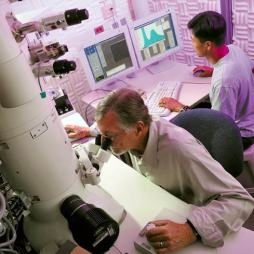Mar 8 2009
Arizona State University will be home to one of the world's most advanced electron microscopes, one that will enable researchers to do work essential to making significant advances in nanoscale aspects of solid state science and materials science and engineering.
 ASU School of Materials professor Ray Carpenter (at left) is pictured doing research with Ph.D. student Young-Chul Kim , using a high- resolution analytical transmission electron microscope at ASU’s J.M. Cowley Center for High Resolution Electron Microscopy. The center will be home to a new state-of-the-art aberration-corrected transmission electron microscope.
ASU School of Materials professor Ray Carpenter (at left) is pictured doing research with Ph.D. student Young-Chul Kim , using a high- resolution analytical transmission electron microscope at ASU’s J.M. Cowley Center for High Resolution Electron Microscopy. The center will be home to a new state-of-the-art aberration-corrected transmission electron microscope.
The National Science Foundation (NSF) Division of Materials Research has approved a grant to fund ASU's $5 million project to acquire an aberration-corrected transmission electron microscope that allows for the clearest possible views yet of matter at the atomic level.
The capabilities of this type of microscope will bolster ASU's stature as one of the top university microscopy research and teaching facilities in the nation. It is the first time the NSF is supporting acquisition of an electron microscope of this kind by a university facility.
"This is a technologically revolutionary instrument that is opening up whole new areas of materials and biological research," said Nathan Newman, a professor in ASU's School of Materials and director of the university's LeRoy Eyring Center for Solid State Science.
"It is an invaluable tool for the future success of nanoscience and nanotechnology, which are fields critical to both national security and economic development," Newman said.
The microscope will be located in the J.M. Cowley Center for High Resolution Electron Microscopy in the Eyring Center, which is part of the School of Materials. The school is jointly administered by the Ira A. Fulton School of Engineering and the College of Liberal Arts & Sciences.
Superior teaching and research
Electron microscopy in the Cowley Center currently supports more than $6 million annually in research expenditures from sources outside ASU. The advanced nanoscale research that the new microscope can provide is likely to mean a significant increase in revenue that can be generated for ASU from new research grants and fees paid for use of the microscope by researchers from industry and other universities, said Ray Carpenter, a professor in the School of Materials and principal investigator for the electron microscope project.
The project is an example of the economic benefit a research university can bring to its state. In this case, the benefit has short and long-term consequences.
In the short term, Arizona benefits from the grant to acquire the microscope itself. In the longer term, Newman said, "having this microscope at ASU will increase the amount and raise the quality of the research that is done here by ASU researchers and others from throughout the country. I would expect that an additional $30 million in grants will be secured in the next seven years as a result of the acquisition of the microscope."
Each year, Arizona universities contribute nearly $1 billion into the Arizona economy from their research, most of which is funded by the U.S. government and entities from outside the state. Research money brought in by universities is restricted money that can be used only for the research activity it supports. It cannot be used to compensate for cuts in other parts of the university's budget.
Carpenter noted that the independent experts who reviewed the project proposal for the NSF acknowledged the past three decades of superior teaching and research in transmission electron microscopy at ASU, and stated that this record of achievement was a major factor in the decision to contribute to ASU effort to obtain the microscope.
Pioneering microscopy work
The new addition to the Cowley center lab - to be purchased and installed over the next two years - will enable researchers and students to get microscopic views of matter minus the tiny obstructions that have blurred images produced by even some of the most sophisticated microscopes of recent times.
"We will be able to probe the bonding of single atoms and examine chemical reactions in real-time at the atomic level," Carpenter said. "This is the level at which the workings of nanotechnology happen."
The successful development of aberration correctors - the result of more than 20 years of research - is beginning to enable subatomic imaging and spectroscopy for materials and solid state research for the first time, Carpenter said.
Solid state science involves the study of the nature and behavior of solids - a state of matter that tends to have a well-defined shape and thus resists changes in configuration and volume. In simple words, solids are those things that can be picked up and manipulated - unlike liquids and gasses. The tools in the Cowley center were initially developed for studies of the synthesis and characterization of such solids, including all semiconductors, metals, ceramics and geological materials.
Clear resolution of electron microscope images has been fundamentally limited by the aberrations of lenses since the first instruments were developed in the 1930s. Despite that limitation, electron microscopy at the microstructure level revolutionized materials and solid state research from 1955 through the 1990s.
Now, with the beginning of the development of interdisciplinary nanoscience, subatomic resolution is required, and aberration-corrected microscopes will fill this critical need, Carpenter said. Indeed, the signature material of nanoscience - carbon nanotubes - was discovered using transmission electron microscopy by Sumio Iijima, a former postdoctoral student and research scientist at ASU.